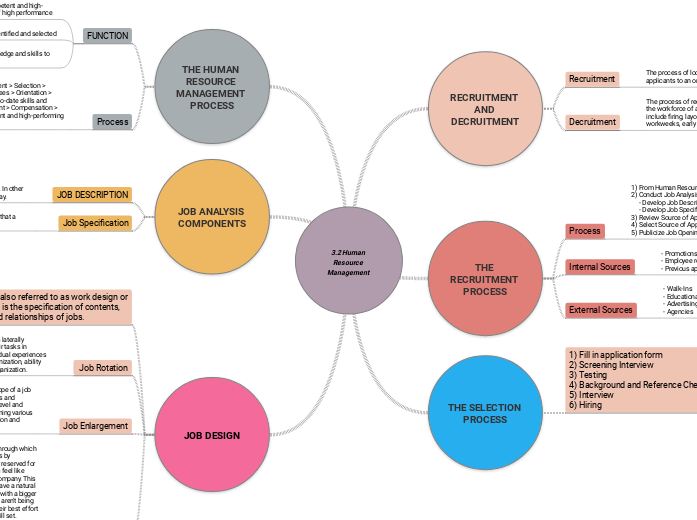3.2 Human Resource Management
RECRUITMENT AND DECRUITMENT
Recruitment
The process of locating, identifying, and attracting capable applicants to an organizations.
Decruitment
The process of reducing a surplus of employees in
the workforce of an organization. Decruitment options include firing, layoffs, attrition, transfers, reduced
workweeks, early retirements.
THE RECRUITMENT PROCESS
Process
1) From Human Resource Needs
2) Conduct Job Analysis
- Develop Job Description
- Develop Job Specification
3) Review Source of Applicants
4) Select Source of Applicants
5) Publicize Job Openings
Internal Sources
- Promotions from within
- Employee referrals
- Previous applicants
External Sources
- Walk-Ins
- Educational Institution
- Advertising
- Agencies
THE SELECTION PROCESS
1) Fill in application form
2) Screening Interview
3) Testing
4) Background and Reference Checks
5) Interview
6) Hiring
THE HUMAN RESOURCE MANAGEMENT PROCESS
FUNCTION
-Ensure that the organization retains competent and high-performing employees who are capable of high performance
-Ensure that competent employees are identified and selected
-Provide employees with up-to-date knowledge and skills to do their jobs
Process
Human Resource Planning > Recruitment > Selection > Identify and Select Competent Employees > Orientation > Training > Provide employees with up-to-date skills and knowledge > Performance Management > Compensation > Career Development > Retain competent and high-performing employees
JOB ANALYSIS COMPONENTS
JOB DESCRIPTION
Identifies the tasks and responsibilities of a position. In other words, it identifies what employees do to earn their pay.
Job Specification
A written statement of the minimum qualifications that a person
JOB DESIGN
Job design (also referred to as work design or task design) is the specification of contents, methods and relationships of jobs.
Job Rotation
Job rotation is a process by which employees laterally mobilize (different department) and serve their tasks in different organizational levels; when an individual experiences different posts and responsibilities in an organization, ability increase to evaluate his capabilities in the organization.
Job Enlargement
Job enlargement means increasing the scope of a job
through extending the range of its job duties and
responsibilities generally within the same level and
periphery. Job enlargement involves combining various
activities at the same level in the organization and
adding them to the existing job.
Job Enrichment
Job Enrichment can be described as a medium through which management can motivate self-driven employees by assigning them additional responsibility normally reserved for higher level employees. By doing this, employees feel like their work has meaning and is important to the company. This theory is based on the premise that employees have a natural tendency to succeed and are eager to be trusted with a bigger role in the company. When these type of workers aren't being challenged, they tend to slack off and not give their best effort because they view their task to be below their skill set. Conversely when an employee is given autonomy over his/her work, they tend to feel responsible for the outcome of the project and will try to put forward the best end result possible.
